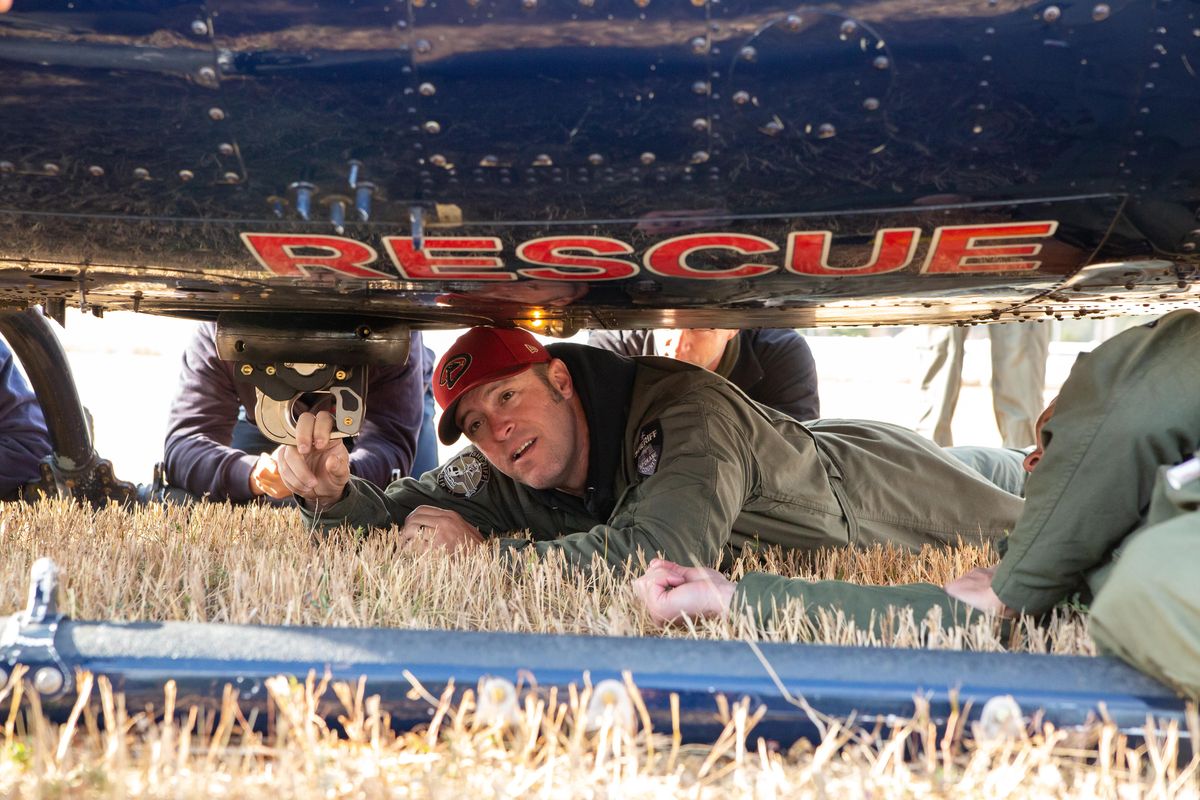Spokane County deputies, area fire departments team up to bring new medic helicopter to the sky

The Spokane County Sheriff’s Office has teamed up with the Spokane Fire Department and the Spokane Valley Fire Department to staff a new rescue helicopter with paramedics, which will allow the rescue of people from remote areas.
The Sheriff’s Office has had a helicopter program for 14 years. It started with one OH-58 helicopter, Air 1, that provides air support for the Sheriff’s Office. A second OH-58 was added a few years ago. In addition to monitoring pursuits and helping find suspects, the helicopters have provided assistance looking for missing people.
In the past if Air 1 or Air 2 found a missing person they were only able to direct ground search teams to the person, said Undersheriff Dave Ellis. They did not have the ability to transport people out. “We’ve always had that gap as far as being able to evacuate people from remote areas,” Ellis said.
The flight medic program is still in the training phase, and volunteer pilots who fly Air 1 and Air 2 are learning how to haul a paramedic and an injured person by ropes dangling from underneath Rescue 3, a 1964 Huey the department obtained through a government surplus program.
Four paramedics from each department have been selected for the program. “They’re not dedicated to the program,” Ellis said. “We want to make a pool big enough that we’ll always have two on-call flight medics.”
Last week the paramedics and pilots were practicing attaching ropes to the helicopter, then taking off slowly and carefully to minimize swing in the rope. The pilots then flew a short distance and practiced letting the rope down in the center of a marked area that served as a target.
“You’ve got to pick up the slack just right,” Ellis said. “We don’t want to have a whole lot of swing.”
As the training advances the crews will add a dummy to the end of the rope, then a person. “It’s kind of a walk, crawl, run thing,” Ellis said.
The volunteer pilots have a range of experience. Some who fly for the Air Force at Fairchild Air Force Base have experience hauling “live loads” while others have not. In addition to learning the needed skills, they all have to learn to speak the same language, Ellis said.
“It’s very strict and standardized,” he said.
The idea is to send someone down on a rope to rescue the lost, sick or injured person and both are flown to the closest clearing so the helicopter can land and load everyone aboard. The department is expecting a hoist in November, which will allow the crew to pull people inside during flight.
Bill Quistorf, chief pilot for the Snohomish County Sheriff’s Office helicopter rescue program, is conducting the training. He’s been flying for 47 years and joined Snohomish County in 2000 after he retired from the Army, where he flew Hueys.
Flying with people dangling from a rope 75 feet underneath you is a challenge, he said. “The pressure is on,” he said. “That’s a lot of stress on the pilot. It just takes patience and skills.”
The rescue helicopter will carry two pilots, two paramedics and crew chief. It’s the crew chief’s job to lean out the open doorway and monitor the people dangling underneath. “We can’t see the load below us so the crew chief is calling out directions,” Quistorf said.
He said the Spokane County volunteers have been doing well in their training. “They’re quick learners, and they’re enthusiastic,” he said.
The helicopter rescue program has been invaluable in Snohomish County because it’s much faster than having rescue teams hike into remote areas. “We can go in a couple hours,” he said. “That can make a difference on whether a person lives or not.”
Air Force Capt. Will Lynn was one of the volunteer pilots doing training this week. He said he’s rescued people before, but only with a hoist. “We do live training a couple times a week,” he said.
The Sheriff’s Office just took delivery of two Super Hueys via government surplus, one built in 1974 and the other in 1973. One will become Rescue 3, and the other will be used for parts. A Super Huey has a larger engine and can carry 13 people, which means it can also be used to drop off ground search crews, Ellis said.
It’s not unusual to fly helicopters that old, and both were just refurbished, Ellis said. “The thing about Hueys is that they go forever,” he said.
The one thing the new Rescue 3 doesn’t have is an infrared camera. Searches will still be conducted with Air 1 and Air 2, which have infrared cameras, and Rescue 3 will be used only for rescues, Ellis said.
The new Rescue 3 should be in the air soon, and the regular Huey being used for training will be sent to Snohomish County. Ellis said he’s not sure when the rescue program will go live because weather may limit the required training.
“It depends on the mission right now,” he said. “It’s a limited capability right now.”